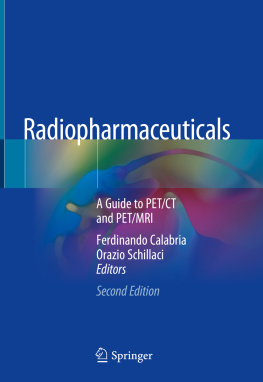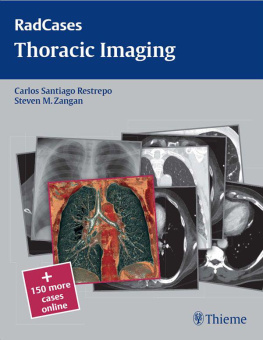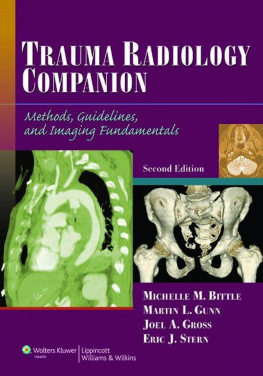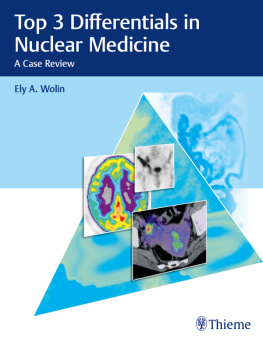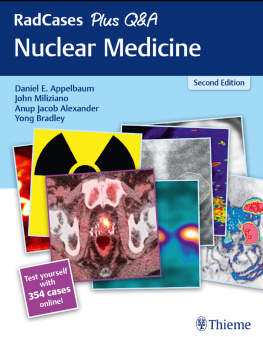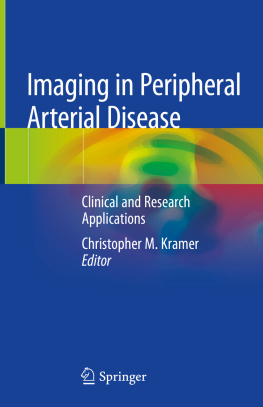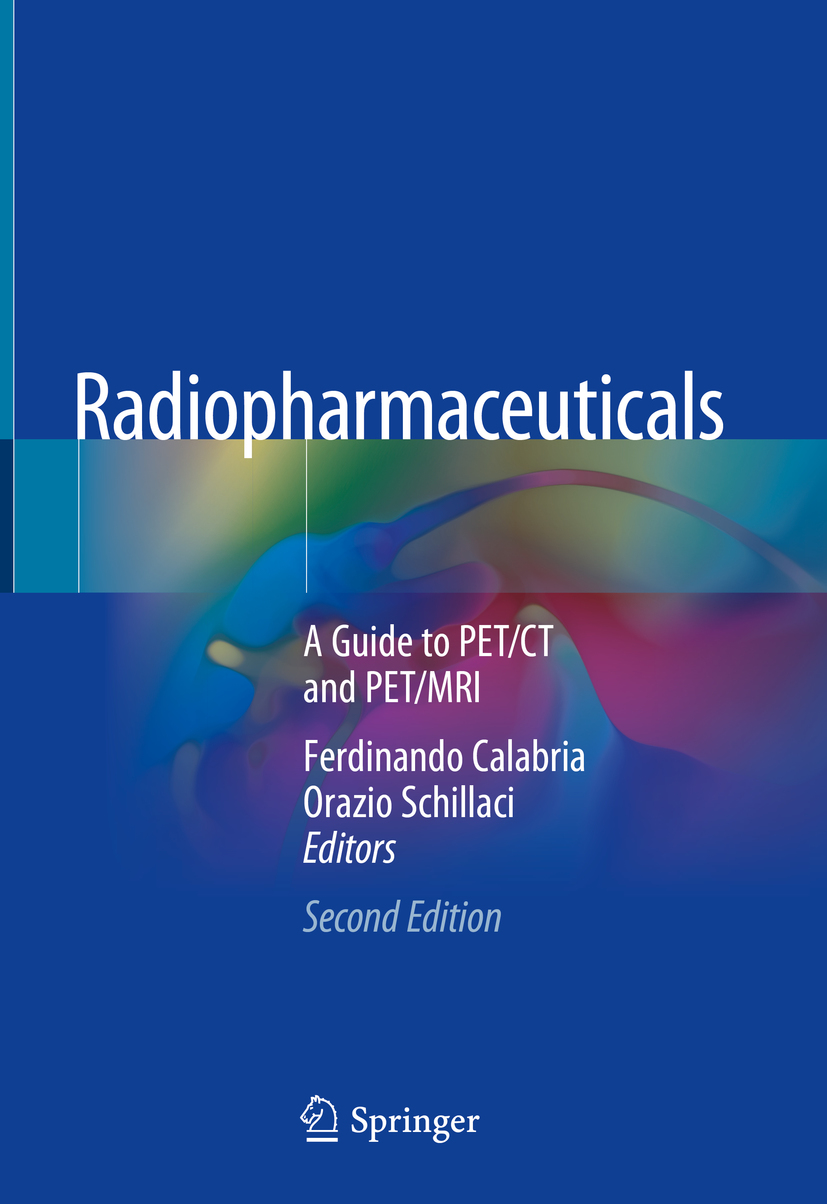Editors
Ferdinando Calabria
Department of Nuclear Medicine and Theranostics, Mariano Santo Hospital, Cosenza, Italy
Orazio Schillaci
Department of Biomedicine and Prevention, University of Rome Tor Vergata, Rome, Italy
ISBN 978-3-030-27778-9 e-ISBN 978-3-030-27779-6
https://doi.org/10.1007/978-3-030-27779-6
2017
by Servizi Scientifici - via Treviso 17/A, 00161 Roma
Springer Nature Switzerland AG 2020
This work is subject to copyright. All rights are reserved by the Publisher, whether the whole or part of the material is concerned, specifically the rights of translation, reprinting, reuse of illustrations, recitation, broadcasting, reproduction on microfilms or in any other physical way, and transmission or information storage and retrieval, electronic adaptation, computer software, or by similar or dissimilar methodology now known or hereafter developed.
The use of general descriptive names, registered names, trademarks, service marks, etc. in this publication does not imply, even in the absence of a specific statement, that such names are exempt from the relevant protective laws and regulations and therefore free for general use.
The publisher, the authors, and the editors are safe to assume that the advice and information in this book are believed to be true and accurate at the date of publication. Neither the publisher nor the authors or the editors give a warranty, expressed or implied, with respect to the material contained herein or for any errors or omissions that may have been made. The publisher remains neutral with regard to jurisdictional claims in published maps and institutional affiliations.
This Springer imprint is published by the registered company Springer Nature Switzerland AG
The registered company address is: Gewerbestrasse 11, 6330 Cham, Switzerland
O.S.
F.C.
Preface
Two years have elapsed since the publication of the book Radiopharmaceuticals , a well-received volume reflecting the state of the art in hybrid PET/CT and PET/MR imaging with novel radiopharmaceuticals. Since its publication, the necessity to cover a larger spectrum of PET tracers has emerged, allowing physicians, residents, and students to deepen their knowledge about PET molecular imaging in a single volume.
Therefore, this edition is enriched by two new chapters, respectively, that focus on prostate cancer imaging with 68 Ga-PSMA and imaging of tau pathology. Previous chapters are also updated by new interesting clinical cases and novel applications.
The panorama of PET molecular imaging has been improved in the last decades by the development of several novel radiopharmaceuticals; some of them play an established role while other tracers are showing interesting preliminary results.
In this scenario, the most useful PET tracer, the 18 F-FDG, shows a limited role in several diseases due to its intrinsic molecular properties while PET imaging is increasingly changing into a diagnostic technique, where the radiopharmaceuticals rather than the scanner can help clinicians in reaching the diagnostic goal. Therefore, amino acid tracers, radiolabeled choline, amyloid tracer, and other radiopharmaceuticals are becoming a valid alternative to 18 F-FDG in specific clinical settings.
Nevertheless, all PET tracers do not completely satisfy an important characteristic of the ideal tracer : the capability to be largely, quickly, and selectively taken up at the target site.
Moreover, the PET imaging has been rapidly improved by the development and commercial availability of hybrid PET/CT and, more lately, PET/MRI scanners, which afford us to enlarge our understanding on the applications of molecular imaging, taking advantage of the concurrent functional and anatomical depiction of the human body.
For the reasons above expressed, the aim of our work is to describe the most common tracers actually used in PET imaging. An essential, synthetic chapter is still targeted on the 18 F-FDG, the milestone among radiopharmaceuticals, in order to describe its actual applications, with a specific paragraph focused on 18 F-FDG PET/MRI.
Thereafter, several novel tracers are presented in each chapter. For all of them, we have described bio-distribution, physiopathology, and kinetics, aiming to describe their specific molecular pathways. For all tracers, we have tried to provide the essential diagnostic features and the most common clinical indications. Moreover, a special paragraph in each chapter describes and comments some diagnostic pitfalls which can occur in clinical practice, while another paragraph describes the most used PET/CT acquisition protocols.
A special interest is given to a large number of clinical cases (more than 170 figures in this new edition), in order to get the reader close to the typical imaging features, pathologic findings, or to the diagnostic pitfalls of all radiopharmaceuticals.
Figures of our book (with several multimodal imaging pictures) also try to achieve different goals, as follows:
Compare potential differences between SPECT and PET imaging
Show the importance of the hybrid-integrated evaluation of PET/CT imaging with the expertise on CT diagnostic criteria
Describe the added value of contrast-enhanced PET/CT in some limited cases
Explain mismatches or overlapping among two different radiopharmaceuticals in the same patient
Realize all the potentiality of correlative MRI and of the hybrid PET/MRI evaluation
Considering the continuous innovation process of nuclear medicine, all chapters are focused on the role of a single tracer or few radiopharmaceuticals. Actually, some chapters are focused on the amino acid radiopharmaceuticals, such as 11 C-methionine, 18 F-DOPA, and 18 F-FET. All these tracers are useful for brain tumor imaging with some analogies, but we have also tried to describe some peculiar applications beyond neuro-oncology.
A specific chapter is focused on radiolabeled choline, including all variants of this useful tracer: 11 C-choline, 18 F-methylcholine, and 18 F-ethylcholine. This chapter is also enriched by new interesting cases, bibliography, and applications other than prostate cancer.
Other important chapters concern imaging of the skeletal system by 18 F-NaF, the myocardial perfusion imaging with 82 Rb, and the -amyloid imaging of dementia.
Considering the importance of targeted radionuclide therapy, two chapters, respectively, regard PET/CT imaging with 68 Ga-labeled somatostatin receptors analogs and the therapy with 223 Ra.
A special section is also focused on the 64 Cu as a versatile nuclide for PET imaging, its possible ligands PSMA, ATSM, and DOTATOC, and their potential clinical applications.
As in the previous edition, particular mention is given to fields other than oncology. In fact, new approaches are described in the study of brain tumors, urological malignancies, functional imaging, forensic use, and the evaluation of phlogosis and inflammation.

